
 |
Tea Clipper |
 |
| from TeaAntiques.com | ||
| Edition Ninety One |
A really beautiful French Sèvres butter dish and cover, exquisitely decorated with hand painted bouquets of colourful flowers. This charming butter dish is clearly marked on the underside of the base plate with interlaced 'L' of the famous Sèvres factory. Inside of the interlaced 'L's is the date letter 'M', equating to 1765.
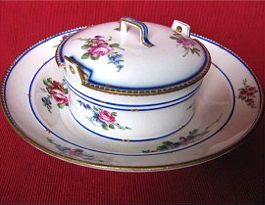
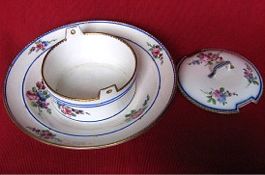
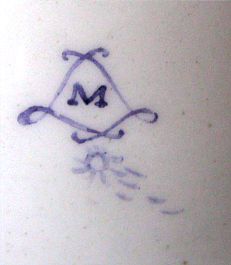
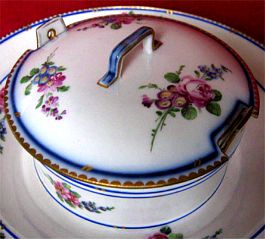 The circular butter tub, which is in the form of a butter 'piggin' with two raised
side handles, is actually part of the base plate as one piece. Then there is a cover
to the butter tub which has two cut outs for it to fit between the two handles,
thus preventing it from slipping off. The whole dish and cover are charmingly decorated
with hand painted and colourful bouquets of flowers, including pink roses together
with blue and purple flowers. The detail of the painted flowers is really beautiful.
On the underside of the base plate, on the inside of the foot rim, is the tiny
blind hole which is where the plate was hung from in the kiln during firing, a detail
to be found on Sèvres manufacture.
The circular butter tub, which is in the form of a butter 'piggin' with two raised
side handles, is actually part of the base plate as one piece. Then there is a cover
to the butter tub which has two cut outs for it to fit between the two handles,
thus preventing it from slipping off. The whole dish and cover are charmingly decorated
with hand painted and colourful bouquets of flowers, including pink roses together
with blue and purple flowers. The detail of the painted flowers is really beautiful.
On the underside of the base plate, on the inside of the foot rim, is the tiny
blind hole which is where the plate was hung from in the kiln during firing, a detail
to be found on Sèvres manufacture.
More details of this item and other tea related antiques can be found by visiting my web site at www.TeaAntiques.com.
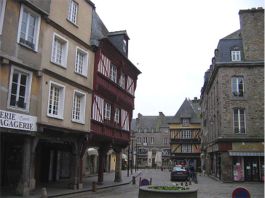 In
the spring of 2008, I took a weekend trip to France on an over night ferry crossing
from my home town in Portsmouth to St Malo on the North West Coast of France. Then,
a 30 minute drive South took me to the picturesque town of Dinan. The town of Dinan
is steeped in history, a medieval walled and fortified town perched high on a hill
above the Rance Valley. There is a great deal to see and do in this town, I spent
a full day exploring it and came across some wonderful sights and was particularly
excited to discover a museum of tea combined with a delightful teashop - more about
this later!
In
the spring of 2008, I took a weekend trip to France on an over night ferry crossing
from my home town in Portsmouth to St Malo on the North West Coast of France. Then,
a 30 minute drive South took me to the picturesque town of Dinan. The town of Dinan
is steeped in history, a medieval walled and fortified town perched high on a hill
above the Rance Valley. There is a great deal to see and do in this town, I spent
a full day exploring it and came across some wonderful sights and was particularly
excited to discover a museum of tea combined with a delightful teashop - more about
this later!
The town itself still retains many of its attractive timber-framed early house at its core. These are built around extremely narrow granite lined streets. The houses, many of them jetted, almost touch each other at the higher levels. This type of narrow street with closely packed jetted houses also touching is what allowed the great fire of London to spread and destroy much of the city in the 17th century, so it is good to know that thus far these here in Dinan survive.
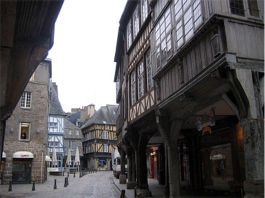
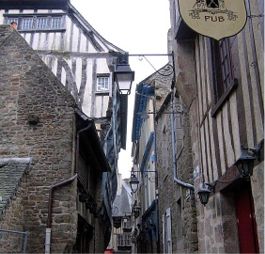
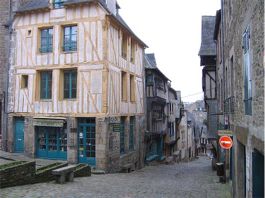
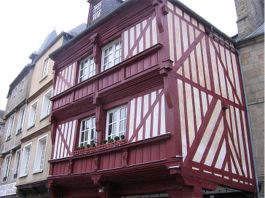 Many
of these early half timbered houses and shops have their timbered frames painted
in charming colours, reds, blues and creams, picking out the fine detail of their
construction. Small leaded light windows still remain in many, these with their
original glass that one can hardly see through because of the striations in the
early glass. As the streets are often very narrow, they are not open to traffic,
making it very pleasant to wander round them. Whilst wandering round these streets
and admiring the things in the little shops, do spare some time to cast your eyes
up, as there is often fine little details, such as carved figures and end posts
to be seen within the buildings construction.
Many
of these early half timbered houses and shops have their timbered frames painted
in charming colours, reds, blues and creams, picking out the fine detail of their
construction. Small leaded light windows still remain in many, these with their
original glass that one can hardly see through because of the striations in the
early glass. As the streets are often very narrow, they are not open to traffic,
making it very pleasant to wander round them. Whilst wandering round these streets
and admiring the things in the little shops, do spare some time to cast your eyes
up, as there is often fine little details, such as carved figures and end posts
to be seen within the buildings construction.
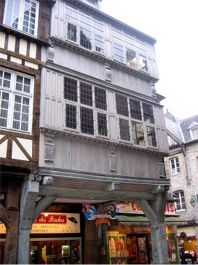
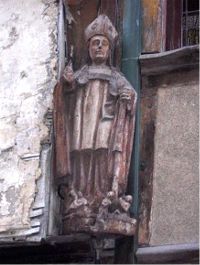
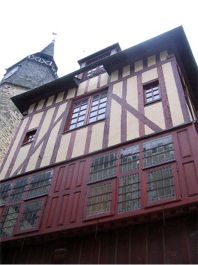
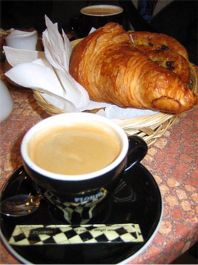 It
is a nice way to start the day, as the French enjoy doing, with a strong coffee
and a croissant - a rich, light and buttery pastry. You will find pleasant of bars
and cafés that will serve such a morning treat.
It
is a nice way to start the day, as the French enjoy doing, with a strong coffee
and a croissant - a rich, light and buttery pastry. You will find pleasant of bars
and cafés that will serve such a morning treat.
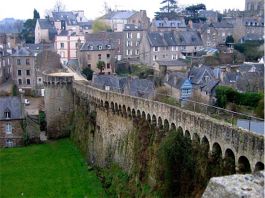 Having
enjoyed just such a morning boost, it was time to take a stroll around the towns
fortified walls. The views from these walls, much of which survive and free to walk
round, are spectacular. At one point it afforded fantastic views to the Rance valley
with the river Rance flowing round the base of the hill. This river flows through
little granite built hamlets where there is an ancient bridge linking the banks.
The river is lined with pleasure boats, although from this point the river narrows
and appears un navigable as it sweeps around the foot hill of the town. An elegant,
but more modern high arched bridge now brings the road across the valley into the
town of Dinan.
Having
enjoyed just such a morning boost, it was time to take a stroll around the towns
fortified walls. The views from these walls, much of which survive and free to walk
round, are spectacular. At one point it afforded fantastic views to the Rance valley
with the river Rance flowing round the base of the hill. This river flows through
little granite built hamlets where there is an ancient bridge linking the banks.
The river is lined with pleasure boats, although from this point the river narrows
and appears un navigable as it sweeps around the foot hill of the town. An elegant,
but more modern high arched bridge now brings the road across the valley into the
town of Dinan.
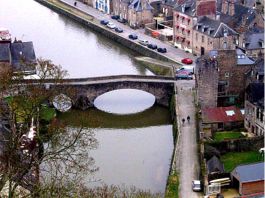
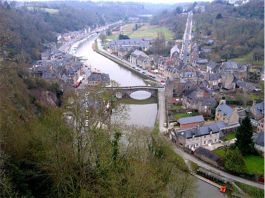
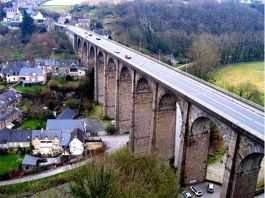
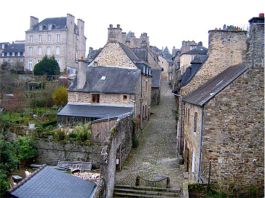 From
the walls of the town, you can also look inward at the town with its many fine and
historic buildings. As well as the early timber framed buildings, there are many
equally fine buildings dating from the eighteenth and nineteenth centuries. Looking
down on the houses from the walls you can also enjoy the little gardens of the houses.
From
the walls of the town, you can also look inward at the town with its many fine and
historic buildings. As well as the early timber framed buildings, there are many
equally fine buildings dating from the eighteenth and nineteenth centuries. Looking
down on the houses from the walls you can also enjoy the little gardens of the houses.
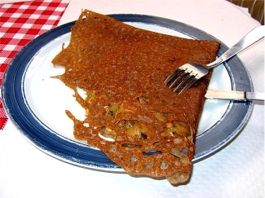 Having
walked around the town walls and explored the town and its interesting and diverse
range of shops, including several antique shops, it was time to partake in a spot
of lunch. Saving myself for afternoon tea, I had one of the local specialities a
galette. Galettes are unique to Brittany and are basically a buckwheat pancake that
is filled with various savoury fillings. The one I chose was a mushroom and lardon
(bacon) filling which included a rich sauce made with port. It was indeed very rich
and extremely tasty and enough to curb my appetite until afternoon tea.
Having
walked around the town walls and explored the town and its interesting and diverse
range of shops, including several antique shops, it was time to partake in a spot
of lunch. Saving myself for afternoon tea, I had one of the local specialities a
galette. Galettes are unique to Brittany and are basically a buckwheat pancake that
is filled with various savoury fillings. The one I chose was a mushroom and lardon
(bacon) filling which included a rich sauce made with port. It was indeed very rich
and extremely tasty and enough to curb my appetite until afternoon tea.
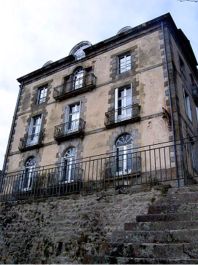
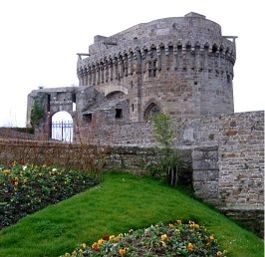
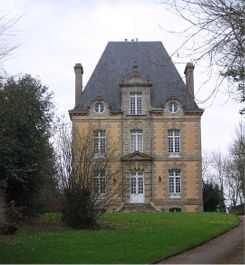
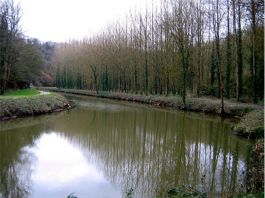 Having now explored much of the town, I took a walk outside of the town walls. On
one side of the town there is a wooded steep slop from the town walls down to the
river below. I discovered a rural 'zig-zag' pathway leading down in what I believe
was a nature conservation area. Making my way down this path the birds were singing
their Spring chorus songs and the spring flowers, such as Primroses, were enjoying
some of the Spring sunshine and warmth. Reaching the river and turning right along
a river bank path around the foot of the hill the air was so peaceful. It is but
a short walk passing an old lock that I reached the sleepy village of Léhon, still
within the shadow of the town of Dinan.
Having now explored much of the town, I took a walk outside of the town walls. On
one side of the town there is a wooded steep slop from the town walls down to the
river below. I discovered a rural 'zig-zag' pathway leading down in what I believe
was a nature conservation area. Making my way down this path the birds were singing
their Spring chorus songs and the spring flowers, such as Primroses, were enjoying
some of the Spring sunshine and warmth. Reaching the river and turning right along
a river bank path around the foot of the hill the air was so peaceful. It is but
a short walk passing an old lock that I reached the sleepy village of Léhon, still
within the shadow of the town of Dinan.
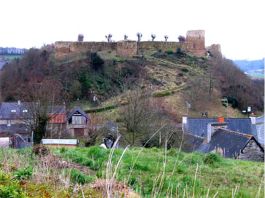
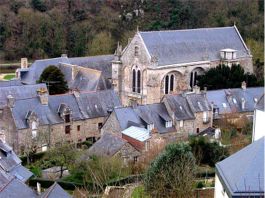
Léhon is another picturesque area of the Rance valley with conserved historic and religious heritage. What remains of this town today demonstrates its importance in feudal days. Since the 19th century, people have come to this site to see the Benedictine abbey which was founded in the 9th century by Nominoë, King of Brittany. There is also the 12th century castle ruins on the feudal mound overlooking the quaint bridge over the river in the town and the Gothic cross in the village of saint-Esprit.
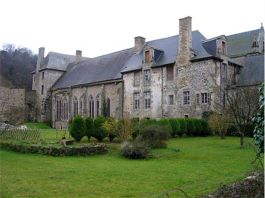
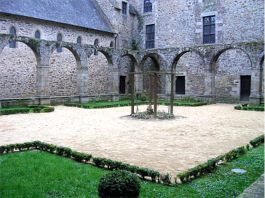
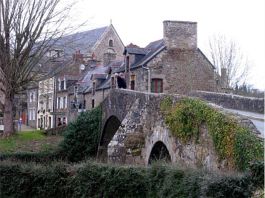
In 1835, the Friars of the Order of saint-Jean-de-Dieu opened a psychiatric hospital, and Léhon's population then doubled in less than a century - today, the town has 3,000 inhabitants. Léhon appears a sleepy town that has managed to retain its ancient buildings whilst integrating them with modern ones for modern day lifestyle requirements. having said that, there is a 'modern' lido close by, which I did not feel integrated at all!
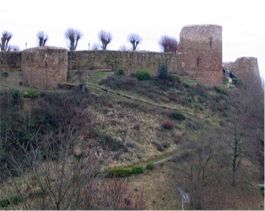 It
It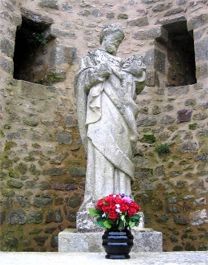 is worth a walk up to see the ruins of the 12th century castle. The castle was first
mentioned in 1034, during the war between the sons of Geoffrey I, Duke of Brittany.
Then in 1168, the castle was besieged by Henry II Plantagenet, King of England.
It was re built in 1169 and again in the course of the late 12 and 13th centuries
by Roland, Lord of Dinan and his successors. The ruins that we see here today date
mainly from this later period.
is worth a walk up to see the ruins of the 12th century castle. The castle was first
mentioned in 1034, during the war between the sons of Geoffrey I, Duke of Brittany.
Then in 1168, the castle was besieged by Henry II Plantagenet, King of England.
It was re built in 1169 and again in the course of the late 12 and 13th centuries
by Roland, Lord of Dinan and his successors. The ruins that we see here today date
mainly from this later period.
From the castle it is but a short walk back up into the walled town of Dinan and time for afternoon tea. In my earlier walk around the town I had discovered the Musée de la Veilleuse Théièe, a museum devoted to tea and integral teashop. Outside, a blackboard listed but a few of the 60 varieties of fine teas available to be enjoyed within the surroundings of what is an amazing museum. Many of the specialist teas are English and Russian blends, and include teas from China, Japan and Thailand.
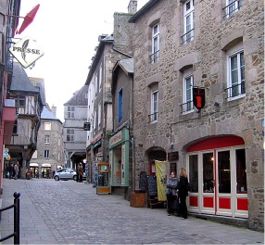
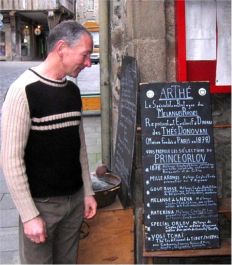
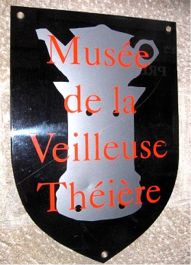
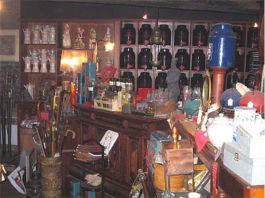
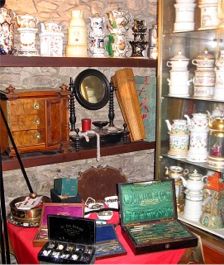 The
atmosphere and ambiance within this museum / tearoom is incredible. It is rather
like stepping back in time and leaving the hurly-burly of modern day living behind.
The museum / tearoom is not large and is absolutely cram-packed with displays in
between which are a number of tables laid ready for tea. The atmosphere is enhanced
by the use of candlelight as well as the electric light for the display cabinets
of antiques.
The
atmosphere and ambiance within this museum / tearoom is incredible. It is rather
like stepping back in time and leaving the hurly-burly of modern day living behind.
The museum / tearoom is not large and is absolutely cram-packed with displays in
between which are a number of tables laid ready for tea. The atmosphere is enhanced
by the use of candlelight as well as the electric light for the display cabinets
of antiques.
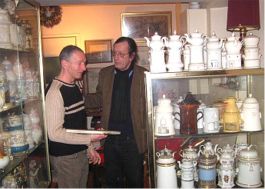 The
proprietor, Gilles Roullier is a rather eccentric character, who delights in the
collection of tea related antiques that he has been collecting since he was a child
and his father before him. He has amassed a staggering collection of Veilleuses,
china pots and burners that were used for heating drinks and food. These include
those used for tea. These involved having a small teapot sat upon a stand in which
would be a burner to keep the tea hot. These are quite a common form of tea equipage
in France in during 18th and 19th century and many within this collection are of
the date and origin. However, we in England also produced this type of teapot and
stand with a burner. Factories such as Wedgwood, Lowestoft and Chelsea produced
them in the 18th century, Wedgwood producing many in Creamware.
The
proprietor, Gilles Roullier is a rather eccentric character, who delights in the
collection of tea related antiques that he has been collecting since he was a child
and his father before him. He has amassed a staggering collection of Veilleuses,
china pots and burners that were used for heating drinks and food. These include
those used for tea. These involved having a small teapot sat upon a stand in which
would be a burner to keep the tea hot. These are quite a common form of tea equipage
in France in during 18th and 19th century and many within this collection are of
the date and origin. However, we in England also produced this type of teapot and
stand with a burner. Factories such as Wedgwood, Lowestoft and Chelsea produced
them in the 18th century, Wedgwood producing many in Creamware.
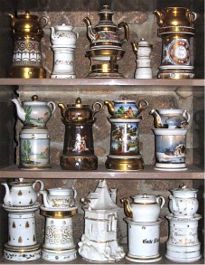
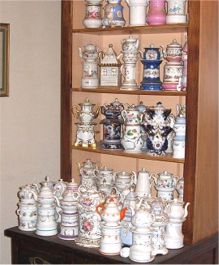
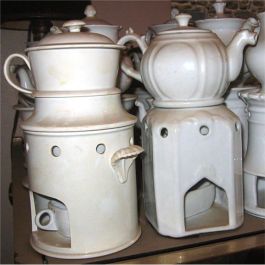
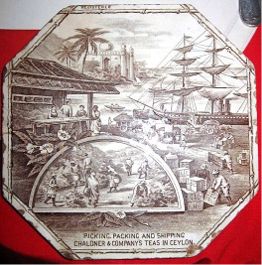
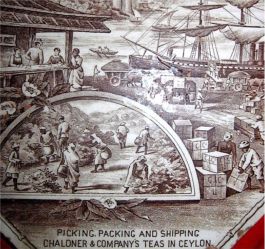 Apart
from the astonishing collection of Veilleuses, which I was shown round by Gilles,
he has a lot of other very interesting tea related antiques. One that I found exciting
was a 19th century Wedgwood hexagonal teapot stand. This wonderful item had a monochrome
print that illustrates the picking, packing and shipping of Chaloner & Company's
teas in Ceylon. Such a synonymous print to have on a teapot stand! It shows the
tea pickers picking the teas from the tea plants in Ceylon watched over by the tea
grower within a fan shaped frame. Around this frame the tea can be seen being packed
into tea chests, carried by elephants and trucks to the tea clipper to be sent to
England - what a treasure.
Apart
from the astonishing collection of Veilleuses, which I was shown round by Gilles,
he has a lot of other very interesting tea related antiques. One that I found exciting
was a 19th century Wedgwood hexagonal teapot stand. This wonderful item had a monochrome
print that illustrates the picking, packing and shipping of Chaloner & Company's
teas in Ceylon. Such a synonymous print to have on a teapot stand! It shows the
tea pickers picking the teas from the tea plants in Ceylon watched over by the tea
grower within a fan shaped frame. Around this frame the tea can be seen being packed
into tea chests, carried by elephants and trucks to the tea clipper to be sent to
England - what a treasure.
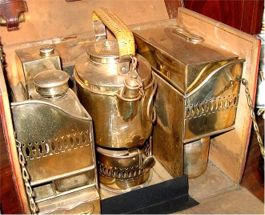
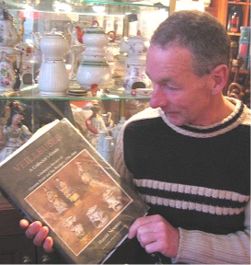 I
was told by Gilles that his museum is one of only two such museums of Veilleues
in the world, the other, which is slightly larger is in Tennessee in the USA. Gilles
was happy to chat about his collection and showed me books and auction catalogues
related to the collection. He also pointed out a travelling tea equipage of silver
in a leather case. He assured me that this delightful set was complete and all in
working order as he had himself used it.
I
was told by Gilles that his museum is one of only two such museums of Veilleues
in the world, the other, which is slightly larger is in Tennessee in the USA. Gilles
was happy to chat about his collection and showed me books and auction catalogues
related to the collection. He also pointed out a travelling tea equipage of silver
in a leather case. He assured me that this delightful set was complete and all in
working order as he had himself used it.
What better place to enjoy tea, than surrounded by such fascinating tea antiques. I ordered a pot of Darjeeling FTGFOP Puttabong' and a 'Tarte Aux Poires À La Frangipane (a pear and frangipane tart). The tea served in white tea pot and tea china was delightful - a very fine Darjeeling tea and the warm tart delicious.
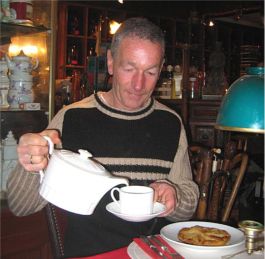
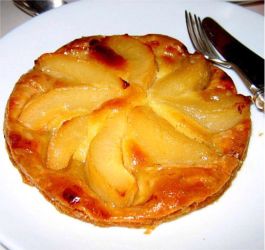
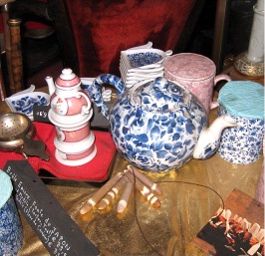
The Musée de la Veilleuse Théièe is the perfect way to end a visit to the picturesque town of Dinan and to be highly recommended.
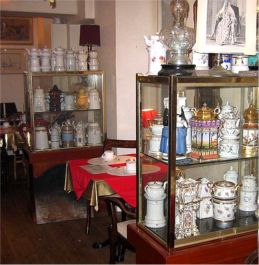
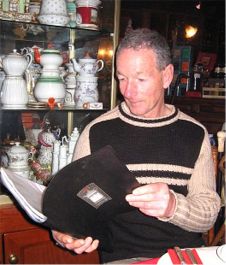
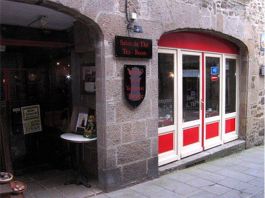
Google map: click here
To review past newsletters, just follow this link:
Past newsletters.
To subscribe to this free newsletter -
Click here